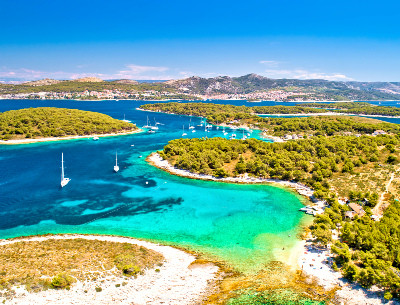Best Things to Do in Croatia
Just a couple of decades ago, Croatia was off the radar of all but the most savvy travelers. In 2011, that all changed when it was spotlighted in the hit series “Game of Thrones.” Visitors started coming in droves to discover what they saw on-screen in person. Today, it’s one of Europe’s hottest travel destinations with a sun-kissed coastline, numerous islands, and historic towns with cobbled streets and ancient treasures. There’s something for everyone, with a wealth of outdoor adventures, wineries for touring and tasting, and plenty of mouthwatering eats throughout. When it comes to the best things to do in Croatia, there’s a long list to choose from, but be sure to prioritize these on your must-experience list.
Dubrovnik is not to be missed during your Croatia vacation as one of the world’s most famous medieval cities. The fictional King’s Landing in “Game of Thrones,” the city is encircled by massive stone walls that span 1.2 miles, with visitors able to walk right atop them. The incredibly scenic stroll brings a bird’s-eye view of the red-tiled rooftops on one side with the endless blue of the Adriatic sea and nearby Lokrum island on the other. There are little cafes and viewpoints for stops along the way. Down below, traverse the pedestrianized Stradun, the main street running through the heart of the Old Town, and marvel at buildings like the spectacular Gothic-Renaissance Rector’s Palace.
Plitvice Lakes National Park is one of Croatia’s most iconic natural attractions, comprised of 16 lakes that range from deep emerald to brilliant turquoise while countless waterfalls are laced in between. Toss in the lush greenery and abundant wildlife that includes rare bird species, wolves, and bears, and the result is one of the most enticing places to discover on your Croatia vacation. Visitors can walk the scenic winding trails in both the Lower Lakes and Upper Lakes areas for views of the falls and the lakes as well as explore by rowboat. Wooden rowboats are available to rent at the Lake Kozjak dock for a perspective of the forested shoreline and smaller cascades from the water.
Whilst in Split, you must visit Diocletian’s Palace in Split, one of the city’s top attractions. Dating back to the late 3rd/early 4th century, it was built as a retirement residence for Roman Emperor Diocletian. Today, it’s home to some of the world’s most well-preserved Roman architecture while serving as the heart of the UNESCO-listed historic center. A massive maze-like complex, many of the buildings that line the twisting streets and alleyways now house little independent shops, galleries, cafes, wine bars, and restaurants. Climbing the 190-foot bell tower at St. Domnius Cathedral, the world’s oldest Catholic cathedral consecrated in the 7th century, brings a panoramic view over the city, Marjan Hill, and the sea.
Sunny Hvar is known for its many beautiful beaches – if you visit during the warmer months, you’ll want to spend at least a day relaxing on one or more of them. Dubrovica is a favorite located about six miles east of Hvar Town. Nestled in a secluded cove, it’s a long pebbly stretch ideal for sunbathing and swimming with crystal clear aquamarine water. Pokonji Dol is arguably the best and most accessible from Hvar Town, about a 25-minute walk away yet rarely too crowded. The water is a brilliant, deep turquoise, incredibly inviting for a dip, while two authentic eateries serve the catch of the day and ice-cold beer. Another good option near Hvar Town is Mekicevica, surrounded by aromatic pines.
Island hopping isn’t just one of the best things to do in Croatia, it’s a must for anyone visiting the country. Whether you do it on a small-ship cruise or by ferry on your own, there are many island gems off the Dalmatian Coast. Most cruises will include several of the main islands, Mljet, Korcula, Vis, Brac, and Hvar, which can all be reached by frequent ferries during the high season (June through September). You might explore Mljet’s famous saltwater lakes in Mljet National Park, wander through the storybook-like Old Town of Korcula, enjoy Vis’s unspoiled nature that includes secluded coves, swim off the shores of one of Europe’s most stunning stretches in Brac, or experience the glamor of Hvar.
Nestled along the west coast of the Istrian Peninsula, Rovinj is a postcard-perfect seaside village with a romantic air. It offers pretty beaches as well as an Old Town filled with cobbled streets and narrow alleyways that are a joy to explore. It’s jam-packed with medieval architecture, dominated by Renaissance and Baroque styles. At the top is the monumental Baroque-Venetian Church of St. Euphemia and its nearly 200-foot-high bell tower stretching high into the bright blue Croatian skies. Modeled after St Mark’s campanile in Venice, it’s topped by a copper statue of Euphemia while providing a panoramic view of Rovinj and its breathtaking surroundings. Witness a glorious sunset from here or the pier extending directly south of the Old Town.
The Istrian Peninsula is renowned worldwide for its wine and food, often compared to Tuscany in Italy with medieval hilltop villages and some of its famous delicacies too, like truffles. A luxury cousin of the mushroom, it’s often on restaurant menus here, used in various pasta dishes and more. Not only should you try them, but you can experience hunting for them, as one of the most unique and best things to do in Croatia. You’ll join a truffle hunter and expert truffle-hunting dogs, traveling into the forest, getting to know the animals and how they’re trained while learning firsthand how truffles are found. Of course, you’ll also enjoy a tasting at the end.
Mljet National Park covers nearly a third of lush Mljet Island as one of the most important protected areas in southern Dalmatia. It’s famous for its two saltwater lakes in many brilliant shades of blue and green, with beaches along their shores. The park also offers many scenic trails that wind through the woods and around the edge of the lakes, with the beaches providing a perfect stop for a refreshing dip. If you do a full circle around the larger lake, Veliko Jezero or Great Lake, you’ll cover about 5.6 miles. You can also hike from the town of Pomena to Malo Jezero (Small Lake) for a spectacular view of the Benedictine monastery in Great Lake along the way.
Ston is a small village on the Peljesac Peninsula less than 40 miles from Dubrovnik. It’s renowned for its oysters, salt works, and its impressive walls. The second longest defensive walls in the world and Europe’s longest, they tower over Ston and the surrounding countryside, stretching for nearly 3.5 miles. The walls were built in the 14th and 15th centuries as a defense for the Republic of Ragusa (Dubrovnik) as well as to protect the area’s lucrative salt pans. They also include three fortresses and multiple towers. Open to visitors year-round, while you walk atop them enjoy incredible panoramic views of the landscape below, including the salt pans, believed to be the oldest in the Mediterranean, used for 4000 years.
Beyond the historic cities and turquoise beaches that have made Croatia so popular, there are acres and acres of centuries-old vineyards but there’s something special about Korcula‘s viniculture. The island produces one of the world’s rarest wines, Grk, which can be sampled not only in the wine bars and restaurants in Old Town Korcula but also at family-run wineries. Posip wine and delicious whites can often be tasted too. A wine-tasting tour at a family-run winery here is sure to be a highlight of your Croatia vacation. There are multiple options to choose from, all surrounded by picturesque views while offering the chance to learn about the winery’s history and the winemaking process, often from the winemaker, while sipping delectable wines.































